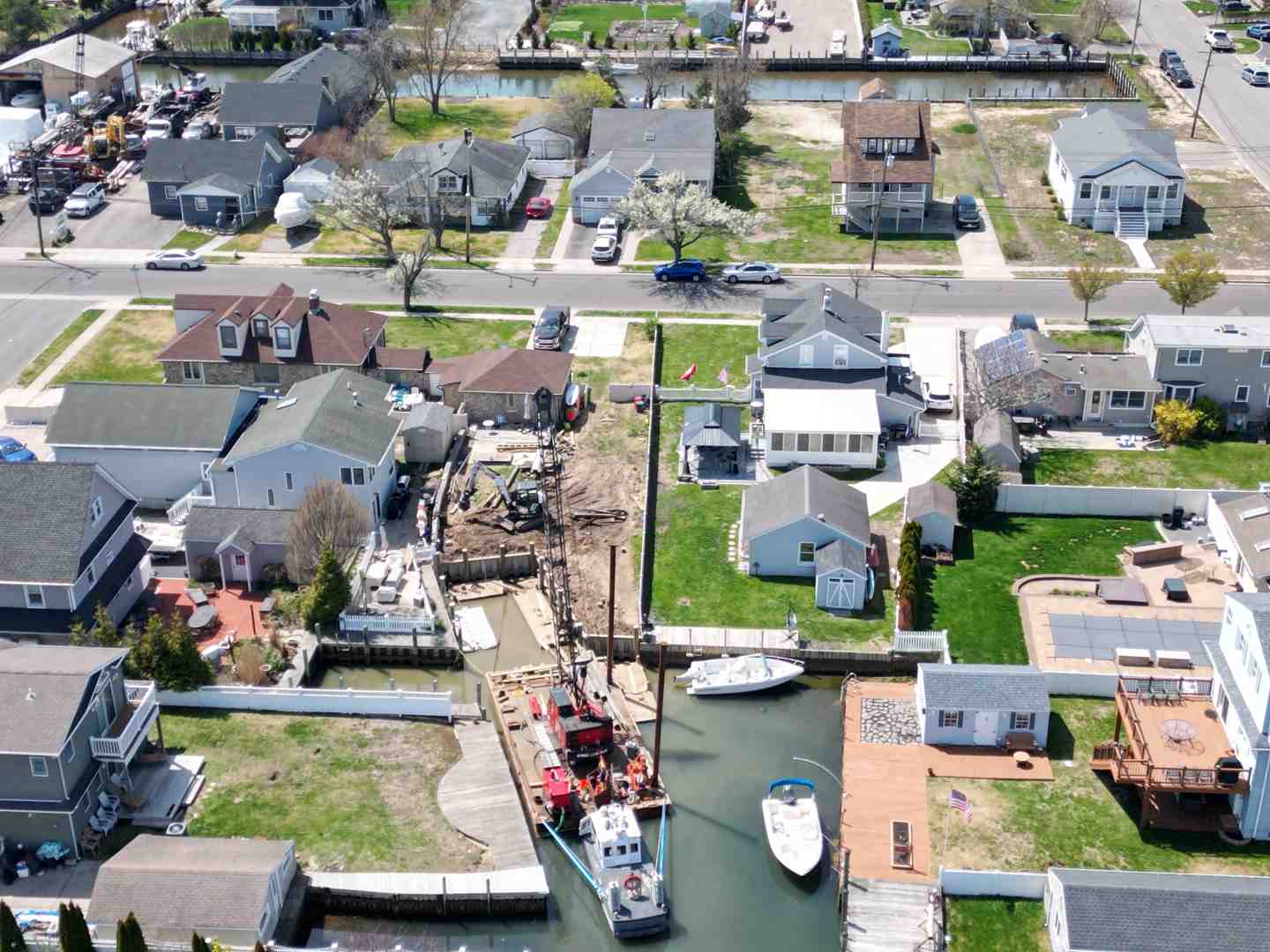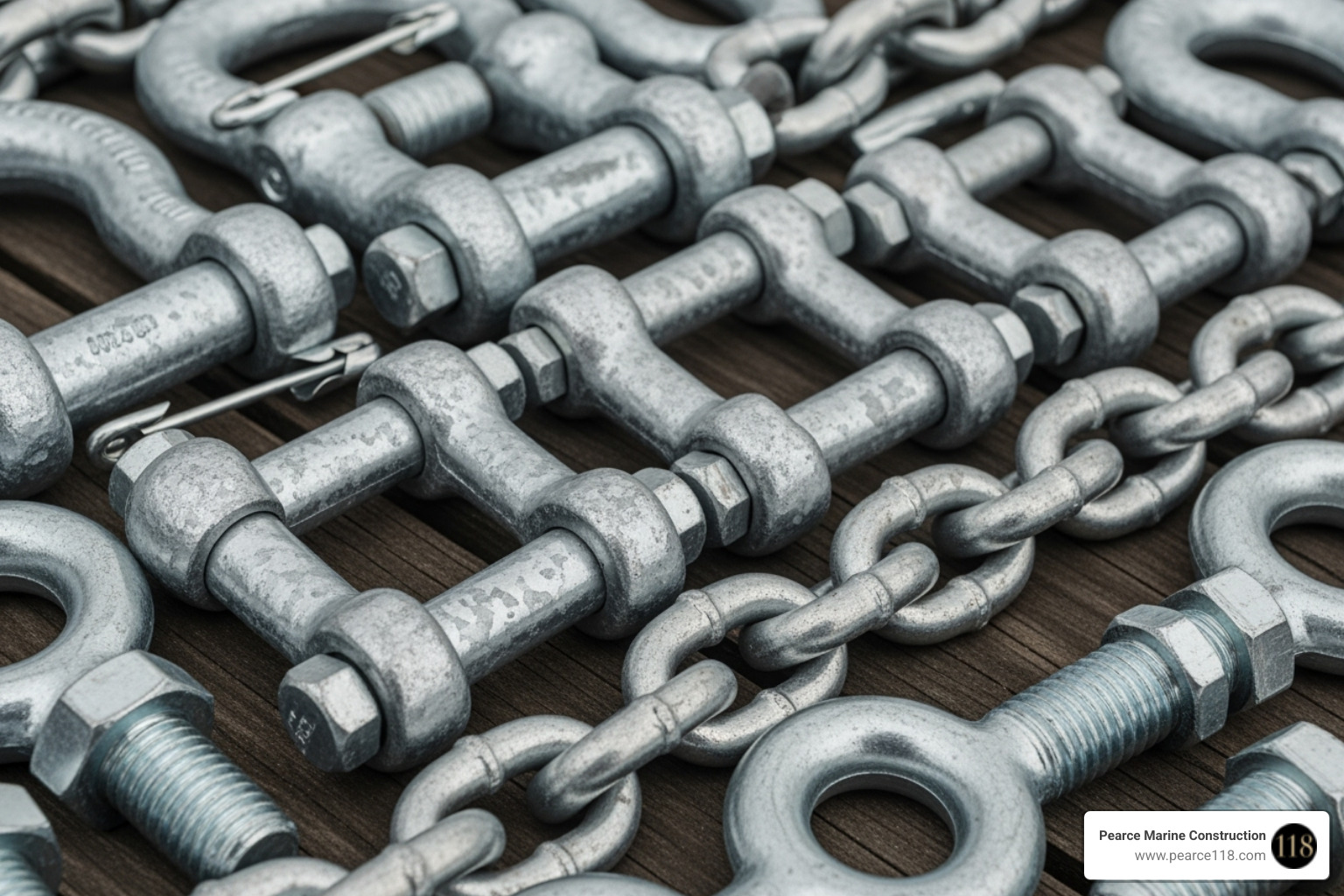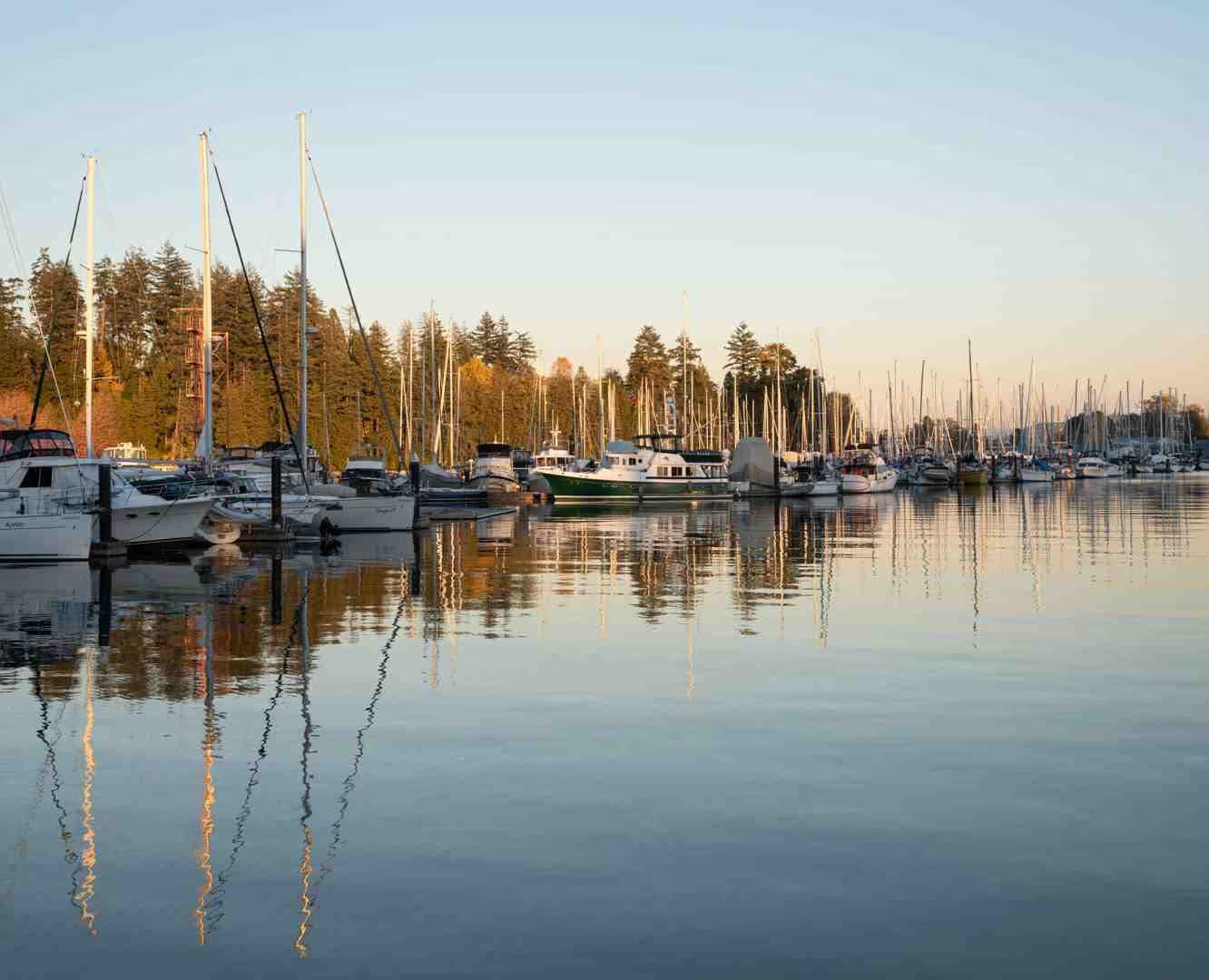Choosing the Right Floating Dock Anchor for Your Needs

Why Proper Anchoring Is Critical for Your Floating Dock Investment
A floating dock anchor is a system designed to secure a floating dock, preventing it from drifting due to wind, waves, and currents. The right system is crucial for protecting your investment, ensuring safety, and extending the lifespan of your dock. Without it, even a well-built dock is a liability during a storm or high tide.
At Pearce Marine Construction, we've seen that the difference between a dock that survives Long Island's weather and one that doesn't almost always comes down to its anchoring. A dock that cost $30,000 can be damaged or lost in a single nor'easter if the anchoring isn't right for the site.
Quick Answer: Types of Floating Dock Anchoring Systems
- Deadweight/Cable Anchoring: Concrete blocks and chains; best for deep water and soft bottoms.
- Pile Anchoring: Vertical poles driven into the seabed; best for heavy loads and large tides.
- Stiff Arm Anchoring: Rigid arms connecting to shore; best for calm, near-shore locations.
- Pole & Sleeve Anchoring: Poles with sliding sleeves; best for windy areas with moderate depth.
This guide will walk you through choosing and installing the right floating dock anchor system. We'll cover the main methods, calculating anchor weights, essential materials, and designing a layout that keeps your dock stable for years.

Know your floating dock anchor terms:
Understanding Your Environment: The First Step in Dock Anchoring
Before selecting an anchor system, a thorough site assessment is essential. Every waterfront location, from the quiet bays of Merrick to the Great South Bay, has unique characteristics that dictate the proper anchoring strategy. At Pearce Marine Construction, we start every project by evaluating these key factors:
Water Depth: We measure depth at high and low tides, as well as seasonal averages. This determines the required chain length and feasibility of certain anchor types. Deeper water (over 8-10 feet) may require specialized installation equipment.
Seabed Composition: The bottom material—be it soft mud, firm sand, or hard rock—is critical. Muddy bottoms are suitable for anchors that dig in, while sandy bottoms work well with heavy blocks or screw-in anchors. Rocky bottoms present a challenge and often require heavier or more numerous anchors to prevent dragging.
Water Level Fluctuations: Long Island's significant tidal swings and seasonal water level changes must be accommodated. A floating dock anchor system must allow the dock to rise and fall smoothly. This adaptability is why properly anchored floating docks are so resilient; FEMA has documented that properly anchored floating docks can protect boats during hurricanes better than fixed docks.
Weather Exposure: We assess the dock's exposure to wind and waves. A key factor is "fetch"—the distance wind can travel over open water. A long fetch creates larger waves and puts more force on your dock, requiring a more robust anchoring system.
Water Body Type: A lake, river, or oceanfront each presents different challenges. Lakes have wind-driven waves, rivers have constant currents and potential debris, and oceans have powerful waves and tides, demanding the most robust floating dock anchor systems.
Environmental Regulations: Permits from local authorities, the NYS DEC, and the Army Corps of Engineers (ACOE) are often required in Nassau and Suffolk Counties. These regulations protect aquatic habitats and ensure safe construction. Our in-house permit service helps steer this process, often securing permits within 90 days to ensure a smooth project start.
For more insights on floating docks in various settings, you might find our article on Floating Docks for Lakes helpful.
Primary Floating Dock Anchoring Systems
After assessing your site, we select the right floating dock anchor system. There is no single best method; the key is matching the system to your specific conditions. At Pearce Marine Construction, we primarily use four methods, each suited for different scenarios.
For a comprehensive look at how these systems work together, visit our detailed guide on Floating Dock Anchoring Systems.
Deadweight and Cable Anchoring
This versatile, time-tested system uses heavy concrete blocks (200-600+ lbs) placed on the seabed, connected to the dock with galvanized chains. The weight provides holding power, while the flexible connection allows the dock to move with water levels. This system is adaptable, works in various depths, and is often the most cost-effective solution, especially in deep water where piles are impractical. However, deploying heavy blocks requires specialized equipment, and it's crucial to account for buoyancy—concrete loses about half its weight underwater. Undersized anchors can drag in strong currents.
Best for: Deep water, soft to firm bottoms, and situations requiring flexibility.
For broader context on dock construction fundamentals, our article on boat dock construction covers the essential building blocks.
Pile Anchoring
Pile anchoring offers maximum stability for heavy loads or challenging conditions. Sturdy vertical poles (piles) are driven deep into the seabed. The dock is attached with brackets or hoops, often with UHMW-PE rollers, that slide vertically along the piles. This provides superior stability against horizontal forces while allowing for tidal movement. It's ideal for large vessels, heavy boat lifts, and areas with strong currents or large tidal swings. The main trade-offs are higher cost and permanence, as pile driving requires heavy equipment and extensive permitting.
Best for: Heavy-duty applications, large tidal ranges, strong currents, and river environments.
Stiff Arm Anchoring
For docks close to shore in protected waters, this system uses rigid steel or aluminum arms to connect the dock to a fixed point on shore, like a seawall or bulkhead. The arms pivot, allowing the dock to move up and down with water levels while preventing all side-to-side movement. This provides excellent lateral stability and a clean, uncluttered look with no underwater lines. However, it requires a suitable shore connection point and is best for near-shore applications with minimal water level changes.
Best for: Calm coves, docks connected to seawalls, and situations requiring perfect shoreline alignment.
For more detailed guidance on shore connections, check out our article on Anchoring a Floating Dock to Shore.
Pole & Sleeve Anchoring
This system is a practical compromise between pile and deadweight systems. Vertical poles are driven into the seabed, and the dock is fitted with galvanized steel sleeves that slide up and down the poles. This allows the dock to accommodate water level changes while the poles prevent horizontal drift. It offers good stability in windy areas and is less intensive to install than a full pile system. While not as robust as full piles for extreme loads, it's a sensible middle-ground solution for many residential docks.
Best for: Windy areas, moderate water depths, and when full pile driving isn't necessary.
Materials and Layout for Your Floating Dock Anchor
The longevity of a floating dock anchor system depends on two factors: quality materials and a smart layout. Cutting corners on either is a mistake that leads to costly repairs.
Importance of Marine-Grade Materials
Saltwater is relentlessly corrosive. We use hot-dipped galvanized steel for chains, shackles, and brackets to ensure durability. In harsher saltwater environments, stainless steel offers superior longevity. A critical concern is galvanic corrosion, which occurs when dissimilar metals touch in saltwater, causing one to corrode rapidly. We carefully match all metal components to prevent this.

We select each component to build a complete, durable anchoring system. You can find more details about our material selection on our page about Dock Anchors for a Floating Dock.
Calculating Your Floating Dock Anchor Weight
Determining anchor weight is a calculation, not guesswork. The goal is to resist environmental forces without over-engineering the system.
- Starting Rule: We begin with a rule of thumb: 600 pounds of anchor weight at the furthest corners and 450 pounds for points closer to shore. Additional anchors are spaced every 24 to 30 feet on larger docks.
- Site-Specific Factors: This is just a starting point. The dock's size, the weight of boats it will moor, and environmental forces like wind and currents can easily double or triple the required weight.
- Buoyancy: A crucial factor is that concrete anchors lose about half their weight underwater. To achieve 600 pounds of holding power, you need a 1,200-pound concrete block on land. We never overlook this calculation.
Essential Hardware: Chains, Lines, and Connectors
The connections are as important as the anchors themselves.
- Chains: For permanent installations, we specify galvanized chains over ropes for their superior strength and wear resistance.
- Chain Length (Scope): A proper scope ratio is critical. We recommend a chain length of 1.5 to 2 times the maximum water depth, plus additional length to account for the full tidal range. This allows the chain to create a more horizontal pull on the anchor, maximizing its holding power.
- Connectors: We use heavy-duty galvanized shackles, quick links, and eyebolts to connect the system. Thimbles are used to protect chains from chafing at connection points, dramatically extending their life.
Designing the Anchor Layout
The arrangement of your anchors determines your dock's stability.
- Crisscross (X) Pattern: This is our preferred design for maximum stability. By crossing the anchor chains—connecting the right-side anchors to the left side of the dock and vice versa—we create a self-tightening system that dramatically limits side-to-side sway. This is a proven method for stability in demanding conditions.
- Straight-Run Layout: This simpler layout connects each anchor to its nearest corner. It offers less stability and is only recommended for small docks in very calm, protected waters.
- Shore Connections: The gangway and shore-mounted connections are also critical anchor points. We use heavy-duty hinges or buried anchor blocks on land to create secure connections. Learn more in our guide on How to Anchor a Floating Dock to Shore.
Installation and Maintenance Best Practices
Proper installation is what separates a temporary fix from a long-term solution. While a skilled homeowner might handle a small dock in calm water, most floating dock anchor projects benefit from professional expertise. Deep water, strong currents, pile driving, and exposed sites require specialized equipment and knowledge. It's always more cost-effective to prevent problems than to fix them later.
When you work with professionals, you get the benefit of Waterfront Construction Services refined over generations of work on Long Island's waterways.
The Construction Process: Anchoring Your Dock Securely
- Anchor Deployment: We use precision techniques, whether lowering concrete blocks gently from a barge or driving piles with hydraulic equipment, to ensure proper placement and holding power.
- Secure Connections: We use heavy-duty galvanized hardware and backing plates to distribute stress evenly across the dock frame. We are meticulous about using consistent metal types to prevent galvanic corrosion.
- Setting Tension: Chains must be tight enough to hold the dock but have enough slack (typically 1-2 feet) to accommodate water level changes. This curve in the chain, or catenary, also acts as a shock absorber.
- Testing: After installation, we test the system by applying pressure to ensure stability and make any necessary adjustments before the dock is used.
Long-Term Care: Maintenance and Troubleshooting
A well-built floating dock anchor system requires regular care to ensure its longevity.
- Inspection Routine: Perform quick visual checks monthly during the boating season. Conduct more thorough inspections in the spring and fall, checking chains for wear and ensuring shackles are tight. An annual inspection should include underwater components.
- After Major Storms: Always inspect your entire system for damage, stretching, or shifting as soon as it is safe to do so.
- Signs of Trouble: Watch for excessive swaying, listing to one side, or unusual creaking noises. These are signs that your system needs attention.
- Storm Preparation: Before a major storm, you may need to add temporary anchors or adjust chain lengths. In some locations, seasonal dock removal is the wisest choice to prevent ice damage.
- When to Call a Professional: While you can handle routine checks, complex repairs, significant damage, or persistent instability require expert help. We are here for routine maintenance or more extensive work through our Marine Structure Restoration services.
Frequently Asked Questions about Floating Dock Anchors
Here are answers to the most common questions we hear from waterfront property owners about floating dock anchor systems.
How do you anchor a floating dock on a river versus a lake?
The primary difference is current. Rivers have a constant force and potential for debris, making pile anchoring the superior choice for its steadfast stability. We often position docks in naturally protected spots and may add secondary deadweight anchors in very strong currents. For lakes, where wind and waves are the main concern, a deadweight and cable system is often sufficient for calm waters. For windier lakes or those with heavy boat traffic, pole and sleeve or stiff arm anchoring provides greater stability.
How much weight is needed for a floating dock anchor?
There's no single answer, but we use a proven formula. We start with a minimum of 600 lbs of anchor weight at the outer corners and 450 lbs for intermediate points, spaced every 24-30 feet. However, this is just a baseline. The final weight depends on dock size, boat size, and environmental factors like wind and current exposure, which can double or triple the requirement. Crucially, we account for buoyancy—a 600 lb concrete block only provides about 300 lbs of holding power underwater. A professional assessment is the only way to guarantee your floating dock anchor system is sized correctly for your specific site.
What is the best way to stabilize a wobbly floating dock?
A wobbly dock is unsafe and usually fixable. First, inspect your existing system for worn chains, loose shackles, or shifted anchors. Ensure you have the right amount of chain slack—not too loose, not too tight. If the hardware is sound, the problem is likely the layout. Switching from a straight-run to a crisscross (X-pattern) anchor layout dramatically improves lateral stability. If wobble persists, the dock may be too light or require a professional upgrade. Solutions like adding stiff arms for near-shore stability or installing piles can provide a rock-solid platform. We can diagnose the cause of the instability and recommend the most effective solution.
Conclusion
We've covered the critical elements of a successful floating dock anchor system, from site assessment and system selection to materials and maintenance. The key takeaway is that proper anchoring is not just a piece of hardware but a complete, integrated system designed to protect your investment. It's the quiet guardian that keeps your dock, boats, and family safe from Long Island's powerful waterways.
Choosing the right method—whether deadweight, pile, stiff arm, or pole & sleeve—and using high-quality materials with a smart layout like the crisscross pattern are paramount. A well-designed and professionally installed system provides security and peace of mind, extending the life of your entire waterfront setup for years to come.
At Pearce Marine Construction, we bring generational expertise to every project. As a woman-owned company serving Nassau and Suffolk Counties, we specialize in custom anchoring solutions built for our local waters. We're here to ensure your floating dock stands strong.
Ready to secure your waterfront future? We'd love to chat! Contact us to discuss your boat and floating dock construction needs.
Bring Your Vision to Life
Whether you're planning a custom dock, seawall, or boat lift, our experienced team is ready to deliver high-quality marine construction tailored to your needs. Pearce Marine Construction brings craftsmanship, precision, and a deep understanding of Florida’s waterways to every project. Let us help you create a durable, beautiful solution that stands the test of time. Get in touch now for a personalized estimate!







